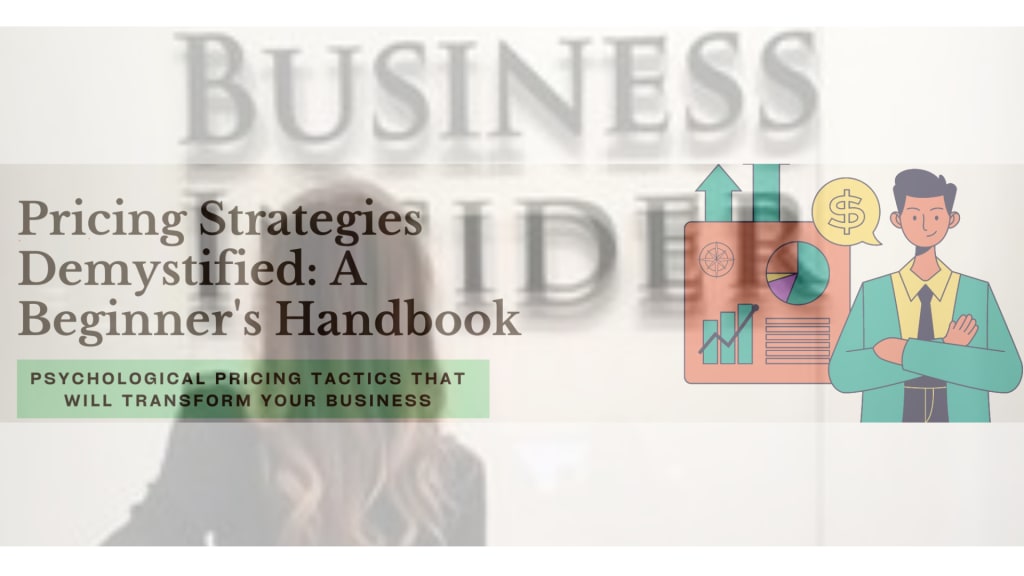Pricing Strategies Demystified: A Beginner's Handbook
Simplifying Pricing Strategies for Novice Business Owners

Pricing Strategies Demystified: A Beginner's Handbook
The value or the worth of a commodity is determined by various factors that mark the intersection of forces of marketing and economics. Price is the value assigned to a product or service based on a complex set of calculations, research and understanding, and risk-taking ability. It is aimed at specific customers and competitors.
Pricing your products and services can be challenging. Setting prices too high means missing out on valuable sales. Set them too low, and you'll lose out on valuable revenue.
Fortunately, pricing does not have to be a compromise or a gamble. Pricing strategies take into account a wide range of business factors, including revenue goals, marketing objectives, target audience, brand positioning, and product attributes. They are also influenced by external factors such as consumer demand, competitor pricing, and general market and economic trends.
Entrepreneurs and business owners frequently skim over pricing. They frequently examine the cost of their products (COGS), compare their competitors' rates, and adjust their selling price by a few dollars. While COGS and competitors are important, they should not be the focus of your pricing strategy.
The best pricing strategy increases your profits and revenue.
Before we discuss pricing strategies, let's go over an important pricing concept that will apply regardless of the strategies you use.
Elasticity of Prices of Demand
The price elasticity of demand measures how a price change affects consumer demand. If consumers continue to purchase a product despite a price increase (such as cigarettes and gasoline), the product is considered inelastic. Pricing fluctuations affect elastic products (such as cable TV and movie tickets). Price elasticity can be calculated using the following formula: Price elasticity of demand is calculated by dividing the percentage change in quantity by the percent change in price. The concept of price elasticity can help you determine whether your product or service is sensitive to price fluctuations. Ideally, your product should be inelastic, which means that demand will remain stable even if prices fluctuate.
Cost, Margin, and Markup in Pricing
When selecting a pricing strategy, it's also critical to understand the role of cost, margin, and markup — especially if you want your pricing to be cost-driven. Let's get into the definitions for each.
Cost
Cost refers to the expenses incurred while manufacturing, sourcing, or creating the product you sell. This includes materials, labor costs, supplier fees, and even losses. The cost excludes overhead and operational expenses such as marketing, advertising, maintenance, and bills.
Margin
Margin (in this case, gross margin) is the amount your company earns after subtracting manufacturing costs.
Markup
The amount you charge for your product in addition to production and manufacturing fees is referred to as markup.
Now, let's get into the details of each pricing strategy.
There are multiple cost strategies:
Premium costing: A high price is used as a defining factor. Such pricing strategies are effective in segments and industries where the company enjoys a significant competitive advantage.
Penetration pricing is when the price is artificially low to gain a large market share quickly. This is done when a new product is being released. Prices will be raised once the promotion period ends and market share objectives are met.
Economy pricing is no-frills. Margins are razor thin; overheads such as marketing and advertising expenses are extremely low. Targets the mass market with a high market share.
Skimming strategy: a high price is charged for a product until competitors allow, at which point prices can be reduced. The goal is to recover as much money as possible before the product or segment attracts more competitors, which will reduce profits for everyone involved.
Pricing Models
While your pricing strategy may influence how your company charges for its overall offerings, the pricing models listed below can assist you in setting prices for specific product lines. Let's have a look.
1. Freemium.
Freemium pricing, a combination of the words "free" and "premium," occurs when companies provide a basic version of their product in the hope that users will eventually pay to upgrade or access additional features.
Unlike cost-plus, freemium is a pricing model that is widely used by SaaS and other software companies. They chose this model because free trials and limited memberships provide a glimpse into a software's full functionality while also establishing trust with a potential customer before purchase.
Freemium prices in advertising and marketing.
Freemium pricing may not make your business a lot of money on the first customer acquisition, but it provides you with access to the customer, which is equally valuable.
Premium pricing.
A premium pricing model, also known as prestige pricing or luxury pricing, is one in which companies price their products high to convey the impression that they are high-value, luxury, or premium. Prestige pricing prioritizes the perceived value of a product over the actual value or production cost. Prestige pricing is a direct result of brand awareness and perception. Brands that use this pricing method are known for providing value and status through their products, which is why they charge more than their competitors.
3. Hourly pricing.
Hourly pricing, also known as rate-based pricing, is widely used by consultants, freelancers, contractors, and other individuals or laborers who offer business services. Hourly pricing is essentially exchanging time for money. Some clients are hesitant to follow this pricing strategy because it may reward labor rather than efficiency.
Hourly Pricing in Advertising
If your company thrives on quick, high-volume projects, hourly pricing can be the perfect incentive for customers to work with you. By breaking down your prices into hourly increments, customers can choose to work with you based on a low price point rather than finding room in their budget for an expensive project-based commitment.
How to Develop a Pricing Strategy
1. Evaluate the pricing potential.
You want to develop a strategy that is ideal for your specific business. To begin, you should assess your pricing potential. This is an estimate of the product or service pricing that your company could achieve based on cost, demand, and other factors.
2. Define your buyer personas.
You must price your product based on the type of buyer persona that is looking for it. When looking at your ideal customer, you'll need to consider:
Customer Lifetime Value.
Willingness to pay and customer pain points.
To aid in this process, conduct interviews with customers and prospects to learn what they do and like, and solicit feedback from your sales team on the best leads and their characteristics.
3. 3. Examine past information.
Take a look at your past pricing strategies. You can compare the difference in closed deals, churn data, or sold products with pricing strategies that your company has previously used and determine which were the most successful.
4. Strike a balance between values and business objectives.
When developing your pricing strategy, make sure the price is appropriate for your bottom line and buyer personas. This compromise will benefit your business and customer base, with the intention of:
Increasing profitability.
Improving Cash Flow
Market penetration
Growing market share
Increasing Lead Conversion
5. Check out competitor pricing.
You cannot create a pricing strategy without first researching your competitors' offerings. When you see the price difference for the same product or service, you'll have to choose between two main options:
Beat your competitors' value - Also known as value-based pricing, you can potentially charge more for your offering if it provides more value to the customer.
Conduct a thorough competitive analysis to understand the competition's entire product or service offering, as well as their strengths and weaknesses, and then adjust your pricing strategy accordingly.
Get Your Pricing Strategy Right.
Pricing involves numerous factors such as competitors, production costs, customer demand, industry needs, and profit margins, which can be overwhelming. Fortunately, you do not need to master all of these factors at once. Simply sit down, calculate some numbers (such as your COGS and profit targets), and determine what's most important to your business. Begin with what you require, and this will help you determine the best pricing strategy to use. Most importantly, remember that pricing is an iterative process. It's unlikely that you'll set the right prices right away; it may take a few tries (and a lot of research), which is fine.
-Hridya






Comments
There are no comments for this story
Be the first to respond and start the conversation.